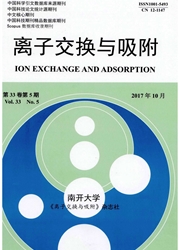

 中文摘要:
中文摘要:
首次尝试以马尾松为原料的木质素制备低成本重金属吸附剂,采用N2物理吸附和红外漫反射技术对其结构和表面化学进行了表征,研究了pH值,温度对其吸附水溶液中Pb^2+的影响,并与麦草木质素和商业活性炭进行了对比,探讨了它吸附重金属离子的吸附机理以及结构和表面化学对重金属离子吸附的影响。结果表明,马黾松木质素吸附荆对水溶液中Pb^2+的吸附机理主要是化学吸附,其表面的功能基有利于吸附水溶液中Pb2+,尽管商业活性炭的比表面积是马尾松碱木素的200多倍,在相同的实验条件下,所制备的马尾松碱木素对Pb^2+的单位比表面积平衡吸附量却是商业活性炭的1000多倍。
 英文摘要:
英文摘要:
In recent years, research on low-cost adsorbents is especially active in the field of adsorption and separation science and technology. In this work, Masson Pine-based lignin was first used to prepare a low-cost adsorbent for heavy metals, the structure and surface chemistry of which were characterized using N2 physical adsorption and DRIFT techniques, respectively. In addition, the effect of pH value and temperature of solution on its adsorption of Pb^2+in aqueous solution were investigated and the adsorption mechanisms as well as the influence of structure and surface chemistry on its adsorption capacity were discussed as compared to a straw-based lignin adsorbent and a commercial activated carbon. Results indicate that chemical adsorption is mainly responsible for adsorption of Pb^2 in aqueous solution on the Masson Pine-based lignin adsorbent and surface functional groups on this material can promote adsorption of Pb^2+ in aqueous solution. The adsorption amount per specific surface area of the Masson Pine-based lignin adsorbent is more than one thousand times of that of the commercial activated carbon, even though the specific surface area of the latter is two hundred times of that of the former.
 同期刊论文项目
同期刊论文项目
 同项目期刊论文
同项目期刊论文
 期刊信息
期刊信息
